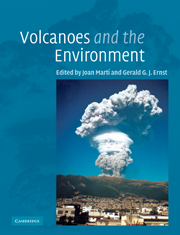Book contents
- Frontmatter
- Contents
- List of contributors
- Preface
- Acknowledgments
- Chapter 1 Understanding the physical behavior of volcanoes
- Chapter 2 Volcano hazards
- Chapter 3 Anticipating volcanic eruptions
- Chapter 4 Volcanoes and the geological cycle
- Chapter 5 Effects of volcanic eruptions on the atmosphere and climate
- Chapter 6 Volcanoes, hydrothermal venting, and the origin of life
- Chapter 7 Volcanism and mass extinctions
- Chapter 8 Effects of modern volcanic eruptions on vegetation
- Chapter 9 Animals and volcanoes: survival and revival
- Chapter 10 Human impacts of volcanoes
- Chapter 11 Volcanoes, geothermal energy, and the environment
- Chapter 12 Volcano-hosted ore deposits
- Chapter 13 Industrial uses of volcanic materials
- Chapter 14 Volcanoes, society, and culture
- Chapter 15 Volcanoes and the economy
- Index
- References
Chapter 7 - Volcanism and mass extinctions
Published online by Cambridge University Press: 14 November 2009
- Frontmatter
- Contents
- List of contributors
- Preface
- Acknowledgments
- Chapter 1 Understanding the physical behavior of volcanoes
- Chapter 2 Volcano hazards
- Chapter 3 Anticipating volcanic eruptions
- Chapter 4 Volcanoes and the geological cycle
- Chapter 5 Effects of volcanic eruptions on the atmosphere and climate
- Chapter 6 Volcanoes, hydrothermal venting, and the origin of life
- Chapter 7 Volcanism and mass extinctions
- Chapter 8 Effects of modern volcanic eruptions on vegetation
- Chapter 9 Animals and volcanoes: survival and revival
- Chapter 10 Human impacts of volcanoes
- Chapter 11 Volcanoes, geothermal energy, and the environment
- Chapter 12 Volcano-hosted ore deposits
- Chapter 13 Industrial uses of volcanic materials
- Chapter 14 Volcanoes, society, and culture
- Chapter 15 Volcanoes and the economy
- Index
- References
Summary
Mass extinctions
Mass extinction events are brief intervals of geological time marked by the loss of numerous species from diverse environments around the globe. Around a dozen such events have been identified and the biggest, known as the “big five,” mark some of the main boundaries of the geological column. The most famous mass extinction is that which brought the 160 Ma reign of the dinosaurs to a close at the Cretaceous–Tertiary boundary: an event that is universally abbreviated to the K–T event (not C–T because this is an abbrevation for Cenomanian–Turonian, a stage boundary in the Upper Cretaceous which, incidentally, is also an extinction horizon). The other four major extinction events happened at the end of the Ordovician, within the Late Devonian, at the end of the Permian (this was the greatest of them all), and at the end of the Triassic (Hallam and Wignall, 1997).
Mass extinctions are of fundamental importance in the history of life because they often eliminate dominant groups from an environment thereby clearing the way for the radiation of previously minor groups. The best-known such changeover concerns the replacement of dinosaurs by mammals as the dominant terrestrial vertebrates in the aftermath of the K–T event. Both mammals and dinosaurs enjoyed a long evolutionary history prior to the end-Cretaceous calamity, but only the dinosaurs occupied the large terrestrial vertebrate niches. The complete extinction of dinosaurs allowed the mammals to evolve to the larger body sizes we see today.
- Type
- Chapter
- Information
- Volcanoes and the Environment , pp. 207 - 226Publisher: Cambridge University PressPrint publication year: 2005
References
- 3
- Cited by



